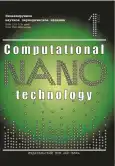An Overview of the Simulation Capabilities for Optimizing the Operation of the Seaport in the AnyLogic Environment
- Autores: Shevchenko A.M.1, Dyda A.A.1
-
Afiliações:
- Admiral G.I. Nevelsky Maritime State University
- Edição: Volume 11, Nº 1 (2024)
- Páginas: 127-134
- Seção: COMPUTER MODELING AND DESIGN AUTOMATION SYSTEMS
- URL: https://journals.eco-vector.com/2313-223X/article/view/631300
- DOI: https://doi.org/10.33693/2313-223X-2024-11-1-127-134
- ID: 631300
Citar
Texto integral
Resumo
Globalization and containerization have significantly increased the volume of shipping in international trade. A seaport is a critical component in maritime transportation. Currently, the main focus for the effective functioning of commercial ports is focused on the use of the latest information technologies. Information support of the port operation is a difficult task for a variety of reasons, the main of which is the external influence on the internal operations of the port and its overall efficiency. Simulation modeling is the most suitable tool for analyzing such a complex interaction. The article defines the characteristic features describing the specifics of the seaport operation in the AnyLogic simulation program. Various possibilities of using the established simulation model are shown to determine the limitations in the size of the throughput and processing capacity of the seaport, substantiate the need to create a “dry” port and select its main parameters.
Palavras-chave
Texto integral
Sobre autores
Anastasia Shevchenko
Admiral G.I. Nevelsky Maritime State University
Autor responsável pela correspondência
Email: anastasiya2100@bk.ru
postgraduate student
Rússia, VladivostokAlexander Dyda
Admiral G.I. Nevelsky Maritime State University
Email: adyda@mail.ru
Dr. Sci. (Eng.), Professor, Department of Automatic and Information Systems (AIS), Faculty of Electronics and Information Technologies
Rússia, VladivostokBibliografia
- Vasin A.V. Modeling of the optimal configuration of the seaport. Bulletin of the Admiral S.O. Makarov State University of Marine and River Fleet. 2019. Vol. 11. No. 4. Pp. 662–669. (In Rus.)
- Glushkov S.V. Building a fuzzy neural network model of an information system for managing the transport and logistics process. Bulletin of the Admiral S.O. Makarov State University of Marine and River Fleet. 2013. No. 3. Pp. 100–112. (In Rus.)
- Kozlov P.A. Automated construction of simulation models of large transport facilities. Transport of the Urals. 2013. No. 2 (37). Pp. 3–6. (In Rus.)
- Korol R.G. Simulation modeling of the operation of a portside railway station with a probabilistic and statistical approach to changing the parameters of incoming carriage traffic. Transport of the Urals. 2014. No. 3 (42). Pp. 53–58. (In Rus.)
- Korol R.G. Technology of functioning of the Vladivostok transport hub in the presence of a multimodal terminal “dry port”. Bulletin of the Admiral S.O. Makarov State University of Marine and River Fleet. 2014. No. 5 (27). Pp. 92–101. (In Rus.)
- Korol R.G., Balalaev A.S. Simulation modeling of the system «Railway station seaport» on the example of the Vladivostok transport hub. Bulletin of the Admiral S.O. Makarov State University of Marine and River Fleet. 2015. No. 3 (31). Pp. 209–216. (In Rus.)
- Kuznetsov A.L. Simulation model in the port of Taman. Seaports. 2013. No. 7 (118). Pp. 34–38. (In Rus.)
- Mayorov N.N., Fetisov V.A. Modeling of transport processes: textbook. manual. St. Petersburg: GUAP, 2011. 164 p.
- Mayorov N.N. Solving the problem of forecasting and operational management of the operation of a marine container line based on simulation modeling. Bulletin of the Admiral S.O. Makarov State University of Marine and River Fleet. 2015. No. 3 (31). Pp. 193–201. (In Rus.)
- Malykhin M.O., Kirichenko A.V. Modeling of the process of handling container trains in the structure of a dry port using the “Block train” technology. Transport of the Russian Federation. A Journal about Science, Practice, and Economics. 2015. No. 1 (56). Pp. 34–36. (In Rus.)
- Morozkov A.G., Yazvenko M.R. Modeling of a sea cargo port as a queuing system in the AnyLogic environment. System Analysis and Logistics. 2020. No. 4 (26). Pp. 59–66. (In Rus.)
- Muravyov D.S., Mishkurov P.N., Rakhmangulov A.N. The use of simulation modeling to assess the processing capacity of seaports and substantiate the need for the construction of a “dry” port. Modern Problems of the Russian Transport Complex. 2013. No. 4. Pp. 66–72. (In Rus.)
- Semenov K.M. Cargo handling planning in seaports and terminals based on discrete event simulation. Dis. ... of Cand. Sci. (Eng.), 05.22.19. Kaliningrad, 2014. 173 p.
- Kaigorodtsev A.A., Rusinov I.A. The development of «Dry ports» in the modern transport and logistics system. Transport Business of Russia. 2017. No. 5. Pp. 105–106. (In Rus.)
Arquivos suplementares
















